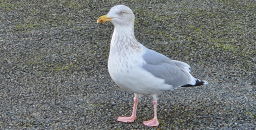The gull colony at Banks Marsh in Lancashire and is part of the National Nature Reserve (NNR) and forms part of the Ribble and Alt Estuary Special Protection Area (SPA). The Ribble is one of 5 SPAs in England where breeding lesser black-backed gull are an SPA feature. At the time of SPA classification in 1993 there were 1,800 pairs. Numbers increased further from 1998, after which time the population remained stable at around 4,000 pairs until 2012. More recent counts have indicated that the lesser black-backed gull population is now around between 6,000 and 8,000 pairs, with the most recent count in 2016 estimated between 6554 to 7022 for Lesser Black-backed Gull and between 780 to 1248 pairs of herring gull. A previous colour ring scheme covered gulls in North West England by David Sowter in 1990s included birds from the Ribble, and occasional individuals from this scheme are still sighted. Following a long period of no ringing for around two decades, ringing resumed in 2019. Plans to ring fledgings in 2017 and 2018 were thwarted by high spring tides inundating all nests, resulting in zero productivity in those years. Going forward the NNR management team have plans to set up long term productivity study plots, and the colour ringing will be a critical element to this.
Ribble Estuary

